The genus Juniperus belongs to the Cupressaceae family, which has about 60 species with more than 100 varieties. Its natural habitat is temperate and cold zones, from the tropical limit to the arctic polar circle. This is one of the few genera of dioecious conifers with male and female flowers, and the only one adapted to living in poor soils. Learn all about how to care for bonsai Juniper in this guide.
Table of Contents
Characteristics Of Juniperus chinensis
It is a genus widely used for its cultivation as bonsai and we could say that it is another of the “classics”. We could say that it is the genus par excellence for the realization of works on dry wood, especially jin and shari, due to the beauty of its wood grain.
Juniperus chinensis is a small evergreen tree or shrub very similar to the common juniper (Juniperus comunis L.) and differs from it in the needles, which are not thorny or needle-shaped, but in the form of flakes.
It has a fibrous bark and is not conical in shape. It flowers in spring and ripens its fruits in the second or third year, which makes it possible to find fruits of several years in various stages of maturation in the same tree.
Its origin is in East Asia (Japan, China, and Korea) and it usually reaches a height of 6.5 – 13 ft (2-4 meters) although in very favorable conditions it can reach up to 32 ft (10 m) in height.
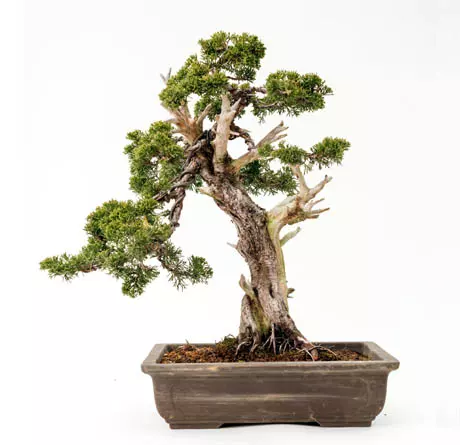
How to Care for Bonsai Juniper
It should be grown outdoors all year round, in full sun, with proper control of watering, as this way we will achieve healthy growth, with a much larger and lush branching.
The outdoor cultivation during the whole year, besides guaranteeing its correct cultivation, will help us to reduce the size of its leaves.
Once its most suitable location has been found, it is not advisable to move it from one place to another because it suffers from frequent relocations.
It should be remembered that during repotting, it should not be placed in full sun, at least for three or four weeks, but in a well-lit place, outdoors, without direct sunlight.
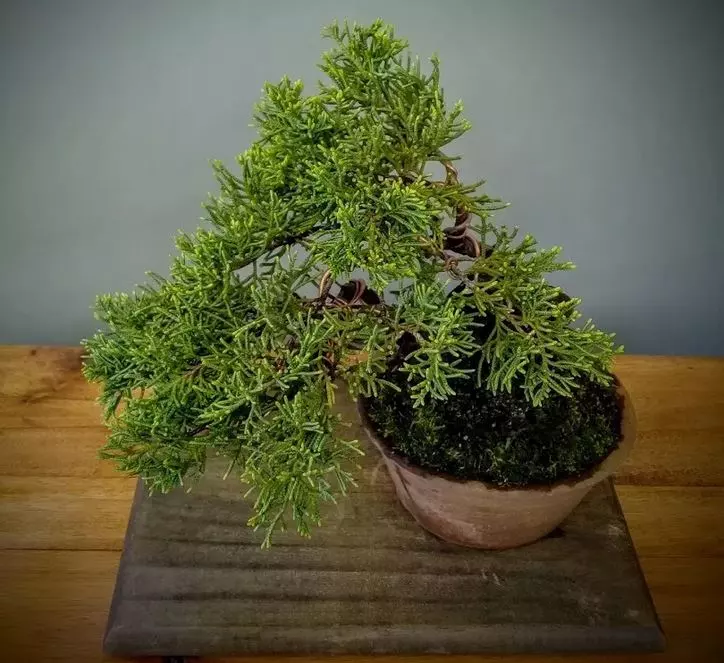
Care Bonsai Juniper – Watering
Watering should be done every time the surface of the soil dries out, doing it thoroughly, that is to say, until abundant water comes out of the drainage holes, but avoiding both permanent waterlogging of the soil, to avoid excess moisture that rots its roots, and leaving the soil completely dry. In any case, an excess of humidity can kill it.
It is convenient to use a watering can with holes as fine as possible so that the water penetrates better in the soil and does it with smoothness.
It appreciates the spraying of the crown with water during the hot season (end of spring/summer), but avoids maintaining an excessively humid environment artificially because we run the risk of fungus.
Care Bonsai Juniper – Fertilizing
Fertilize frequently with a quality organic fertilizer, especially during the period of vigorous growth, i.e. in spring and also during autumn. During the winter and the hottest part of the summer, the amount of fertilizer should be reduced because these are times with little or no growth.
We can help to reduce the size of the leaves, in addition to a good outdoor exposure to full sun with the supply of fertilizers richer in phosphorus (P) and potassium (K) than in nitrogen (N) so as not to encourage the development of its leaves, in addition, we encourage fruiting.
Do not forget that:
– We should NOT fertilize a repotted tree, we must wait for it to sprout.
– We should NOT water a tree grown outdoors after a frost or when there is a risk of frost.
Care Bonsai Juniper – Repotting
It should be repotted every 2 to 3 years in early spring, just before bud break of the year begins when the buds are swollen but not yet open. Older, more mature specimens can be repotted less frequently, every 4 to 5 years.
During repotting it is advisable to clean up any rotten roots and prune unwanted branches to reduce the crown. It is not advisable to prune too many roots, but if the root pruning is too strong, it is advisable to remove leaves in the same proportion as the removed roots.
It is not compulsory, but if we use rooting hormones with fungicide we will facilitate the success of the repot by stimulating root development (Order it here). You should be as quick as possible during repotting and prevent the roots from drying out by being too long in contact with air.
A good soil mixture could be a mixture of soil with 30% coarse-grained sand or equivalent material (volcanic soil, etc.), 10% peat and 60% mulch, or any of the prepared mixtures that can be found in specialized stores (Order it here).
Do not forget that the soil used must always be new and clean and never reused from other crops to avoid contamination (fungi, diseases, pests, etc.) that could have affected other trees.
It is advisable to protect the tree after repotting for a couple of months, placing it in a well-lit place but avoiding direct exposure to the sun. Repotting is very important for the care of the bonsai Juniper.
- 🌟 ESSENTIAL NUTRIENTS — Your Bonsai will be Living in this Stuff For Their Whole Life; Multi-purpose Organic Blend, Consistent Long Term Enriched Growing Medium
- 💧 WATER MANAGEMENT— Fantastic Water Control for Bonsai's and Drains Excess Moisture from Soil; Perfect for Conifers of All Types Including: Junipers, Redwoods, Cedars, and Pine Trees
- 🇺🇲 PROFESSIONALLY MIXED IN THE USA — From the Growers at Perfect Plants, Amazing When Used with All Bonsai Tree Types
Pruning Juniper Bonsai
The most suitable time for pruning branches is between late fall and winter, although growth buds can be cut during the summer to keep the vigor of the tree under control and to model its shape according to the chosen style.
Pinching is a technique used in this species to increase the thickness of its crown and shape its style. The proper way is to remove, using the fingers of the hands, approximately 2/3 of the new shoots when they are still tender, without forgetting the vigorous areas to balance the tree. Be careful not to pinch too early to prevent the internodes from getting too long, but do not wait until the new shoots have matured so much that they can no longer be pinched with the fingers.
If we pinch the new shoots, especially in the most congested areas, and leave only those we will need for shaping, we will get more branched and compact trees, with even smaller leaves.
Junipers are usually shaped in the following styles: moyogui or informal straight, chokkan or formal straight, shakan or inclined, or yose-ue or forest, although it all depends on your imagination and taste.
Withered leaves and fruit should be removed to prevent fungus, and unwanted or dry branches can be removed at any time.
Never prune drastically if the tree is not healthy and vigorous.
In addition to pruning for shaping, pruning should be done to achieve a structure that allows light to reach all branches and all leaves to photosynthesize.
Finally, remember that pruning or pinching should only be done if the tree is healthy.
- 16 BONSAI TREE KIT - The Bonsai Kit including 1 x Bonsai Scissors,1 x Long Scissors, 1 x Pruning Shear, 1x Mini Wide Shovel,1 x Mini Shovel,1 x Mini Rake, 4 x Bonsai Wires, 2 x Leaf Cutters,2 x Tweezers,1 x bucket shovel, 1 x Organizer Bag. If you are a bonsai beginner, you will find this is a good bonsai starter kit!
- CARBON STEEL SCISSORS FOR GARDEN - Made of high carbon steel, Bonsai Scissors, and Long handle scissors are super suitable for bonsai and other potted plants pruning, shaping, and other quick cutting. Quality pruning shears ideal for cutting stems and light branches, can cut up to 3/4" diameter size, this may vary depending on tree species. Polished by hand, it's stronger, sharper, and more durable than other materials. Wipe clean and lightly oil after every use will let them last a lifetime.
- BONSAI TRAINING WIRE - 2 different diameter Bonsai Training Wire (4 coils) in the garden tool set. You can use them to shape the bonsai tree. The bonsai wire is flexible and strong enough. There is no problem to bend and twist many times. Not breaking at all.
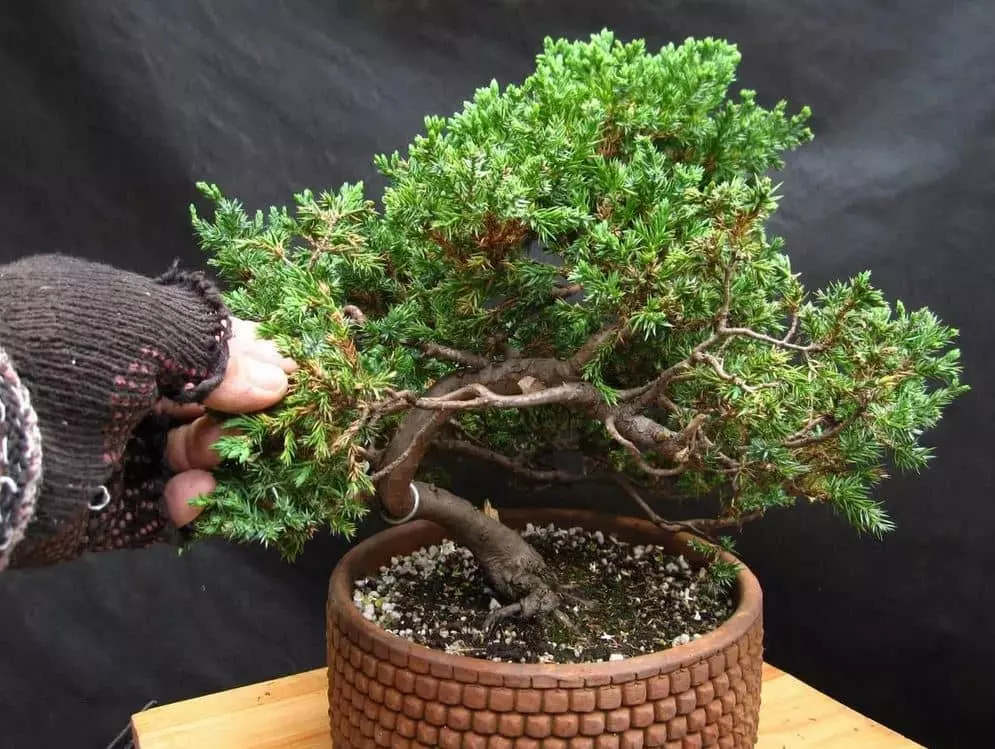
Wiring Juniperus chinensis
Wiring of junipers can be done year-round, but it is preferable to do it in the fall, winter or spring before new shoots open, preferably after pruning, and only on healthy trees. Although its branches are relatively flexible, be careful with the bark on the trunk and branches. You may need to wire more than once until the thicker branches are in the desired position.
You should watch for wire marks on the bark because of the rapidity with which they fatten and grow, generally, the wire should be removed as soon as the bark marks begin to appear. It is advisable not to water the day before wiring.
A tree that looks like a “skein of wire”, due to the excess of wire, loses all its lively aspect and is not a better specimen as a bonsai. Please wire just enough and only when other shaping techniques cannot be used or have not achieved the desired effects.
- 1.This set is useful for advanced bonsai enthusiasts and beginner bonsai gardeners alike,Because this Bonsai Tools Kit Set is made of high quality carbon steel
- 2.Including Leaf Trimmer, Scissors, Jin pliers, Root Hook, Knob Cutter, Aluminium Wires and Wire cutter, etc.
- 3.By using this Popular selection of tools kit, you will be able to loose the bonsai soil, pruning, cut the root, branches, leaves trimming.
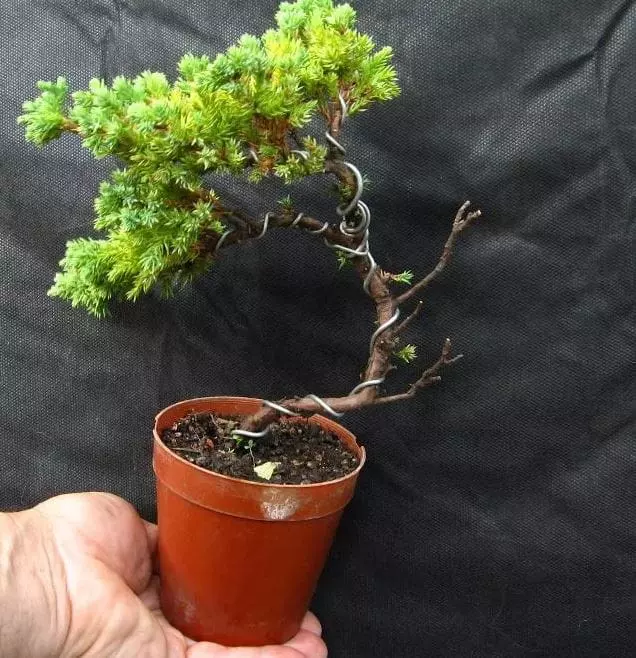
Most Common Diseases and Pests
Junipers are usually quite resistant to pests and diseases, but, in any case, some of the diseases or pests that can attack them are:
– Branch dieback: usually affects the tips of one-year-old branches of young specimens. These turn yellow or brown and eventually die. There is no method to combat this disease, although a manganese and magnesium deficiency may favor its appearance. The only thing we can do is to prune the diseased shoots back to healthy wood.
– Juniper mealybug: sap-sucking insect with a flat, rounded shape (females) or elongated and rectangular (males).
– Aphid: like the mealybug, it is a sap-sucking insect usually brown or black.
– Juniper black mold: develops on the honeydew of aphids and coats both leaves and stems with a layer of black mold. It can cause yellowing and death of the plant.
– Juniper moth: dark brown, striped caterpillars that dry out affected leaves. The affected areas are held together by silk threads. Sometimes it is enough to prune the branches affected by the chrysalides at the end of spring or beginning of summer, but if this is not enough, a specific product should be applied.
It is very important to detect these pests and diseases in time for the correct care of the bonsai juniper. Learn more about How to Prune Bonsai.
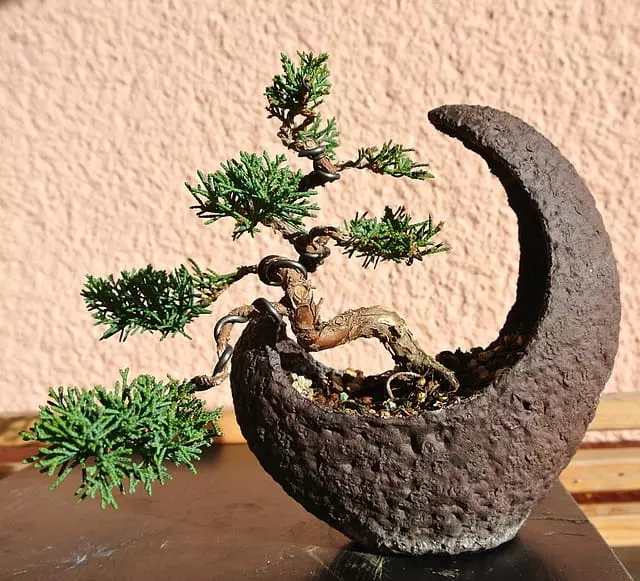
Where to Buy Juniper Bonsai Tree?
If you still don’t have your Juniper bonsai and you want to have a quality Juniper bonsai here are the best Juniper bonsai sellers.
Once you have your Juniper bonsai be sure to follow all the tips we gave you in this guide so you can take care of your Juniper bonsai.







